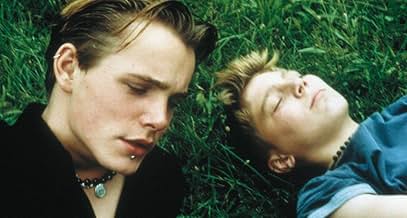Ein 15-jähriger Junge aus Long Island verliert alles und jeden, den er kennt und gerät bald in eine Beziehung mit einem viel älteren Mann.Ein 15-jähriger Junge aus Long Island verliert alles und jeden, den er kennt und gerät bald in eine Beziehung mit einem viel älteren Mann.Ein 15-jähriger Junge aus Long Island verliert alles und jeden, den er kennt und gerät bald in eine Beziehung mit einem viel älteren Mann.
- Regie
- Drehbuch
- Hauptbesetzung
- Auszeichnungen
- 20 Gewinne & 18 Nominierungen insgesamt
- Howie Blitzer
- (as Paul Franklin Dano)
- Brian
- (as Tony Donnelly)
- Man with Pizza
- (as Frank G. Rivers)
Empfohlene Bewertungen
Instead, Dano joins Kay in house burglaries, with incestuous James Costa (as Kevin Cole) and hetero stud Tony Michael Donnelly (as Brian). One of the homes they hit belongs to boy-trolling ex-Marine Brian Cox (as "Big John" Harrigan). Apparently, Mr. Cox is having trouble maintaining interest in aging boy-toy Walter Masterson (as Scotty). After Kay books for California alone, and Dano's father is arrested, he finds not only the sexual stimulation missing from Kay, but also a father figure, with the older Cox.
Due to the subject matter, this was obviously a controversial film. It contains what they call "strong language," but nothing offensive is explicitly shown. It's a tribute to director Michael Cuesta that such a fuss seems to have been made - at one point, the film was labeled NC-17 - because, Mr. Cuesta tells the story with implicit effectiveness. Editing and cross-cutting are used well. Cuesta and his cast deservedly won awards for their work. Still, nobody's perfect, and only an idiot would visibly trick behind that sign.
"Welcome to Long Island" Dano begins the "L.I.E." story by saying, "You got the lanes going east, you got the lanes going west. You also got the lanes going straight to hell." The ending, with Mr. Masterson, is an old story, but unexpectedly uplifting in this context (only).
******** L.I.E. (1/20/01) Michael Cuesta ~ Paul Dano, Brian Cox, Billy Kay, Walter Masterson
L.I.E stands for Long Island Expressway, a commuter-crowded freeway running like a knife slash through an affluent New York suburb; for Cuesta 'a metaphor for a kid who's about to be sent into the scary world of adulthood regardless of whether he's ready or not'. A hazardous route then which, we learn, has already killed 'Cat's in the Cradle' singer/songwriter Harry Chapin, All the President's Men director Alan J Pakula - and the mother of L.I.E.'s 15-year-old Howie (a remarkable performance of put-on adolescent toughness, vulnerability and knowing from Paul Franklin Dano). The 'lie' of the title symbolising the myth of cosy suburbia but more pertinently, the casual or far-reaching deceits L.I.E.'s guilt-edged cast of slack-jawed wide boys, footloose rent boys, corrupt white-collar contractors and 'always ashamed' Chicken Hawks will visit on themselves and one another, emotionally hobbled, or shot-through with grief, every one.
If L.I.E initially drew comparisons with the work of Harmony Korine, Larry Clark - and Todd Solondz in particular, Cuesta's film contains a warmth and delicacy often lacking from these fellow chroniclers of suburban juvenile woe. The semi-autobiographical script, by Stephen M Ryder and Michael and Gerald Cuesta, is kinda different too - frank without being exploitative, and unexpectedly tender, with no pussyfooting at all. As Cox says, 'original, brave - kind of groundbreaking'. While that old stand-by of Indiedom, the roving hand-held is present and correct, if refreshingly unobtrusive, Romeo Tirone's exquisite cinematography further distinguishes L.I.E. from its sullen contemporaries, combining a stark, saturated quality (most effectively for the sterile look of soulless 1980s houses) with the smooth visual finish of a Michael Mann.
Perhaps its nearest equivalent is David O Russell's taboo-fest from 1994, Spanking the Monkey, another portrait of inter-generational relationships (plain old incest in this case) played out against the backdrop of suburban blitz - long a fertile slouching ground for independent filmmakers. As former photographer Cuesta, a Long Island native, whose boyhood memories brought a lot to bear on the film's innate truthfulness, says: 'Suburbs have their own cultures, rhythms, ethics, and morals.you have everyone from the Mafia to the artists to 9-5 commuters, and it's certainly true that there's a story behind every door and at the end of every driveway. A big part of making L.I.E. feel real had to do with the inherent realism that comes with shooting near a major highway. That constant hum of traffic permeates every neighbourhood - everyone deals with that sound.'
We first encounter Howie teetering on the brink of a burgeoning, ambivalent sexuality. Literally teetering, as the opening shot describes, balanced precariously on the edge of a flyover. Abandoned by everyone - his father, friends, and schoolboy crush Gary (a shimmeringly anarchic Billy Kay) the sensitive Howie finds emotional rescue with the mysterious 'Big John' Harrigan. An exuberant bear of a man, a curious Harrigan attempts to bewitch an amusedly reticent Howie with allusions to a thrillingly glamorous past, man and boy engaged in teasing, fumbling power play - until an unlikely, neo-parental alliance is at first grudgingly, then preciously forged.
'It was vital the audience could relate to Big John, even sympathize with him', says Cuesta. '(But) I tried very hard to make sure his intentions were constantly blurred'. For Cox, the role (one of his greatest performances) was 'potentially, a career-burying move. There were enormous dangers in it. But I weighed up the odds - and decided the whole point of not doing it were the very reasons to do it. I was really intrigued by how far one could take the character and make it work. The first trap an actor could fall into would be to play Big John as a man whose public façade disguised the fact he was a sexual predator. I took the opposite view: that he was this wonderfully open character, and actually a very nice man - who happened to be a pederast. And the range became so much bigger. It's a story of redemption, and that's what finally came through for me. It's a very responsible film.'
Big John isn't strictly a pedophile as no prepubescent children are involved in his life but he certainly appears to be a pederast. He cruises the local pick up zone where teen-aged male prostitutes ply their trade offering blow jobs behind a road sign for a few bucks. And there he meets 16 year old Gary, a good looking local tearaway and hustler who also burgles houses with his school mates for extra cash.
Gary isn't necessarily gay but he uses his looks and charm to best advantage. Accordingly he is the object of adoration by 15 year old Howard, a gay school mate, who dreams of running off with Gary to a romantic life together in California.
But their plans and dreams must change when they decide to rob Big John of his prized antique revolvers - and the ex marine quickly discovers their guilt.
The subsequent drama is beautifully intense without being heavy. And most of all it raises essential questions about the true nature of pederasts and the boys they befriend. Who is exploiting who? Who is the real victim of this sadly common circumstance? Are pederasts always evil? What exactly are the real motives of Big John, Gary, Scott and Howard? And who is the villain? The film ends very suddenly with an emotional shock. And it is our personal feelings towards the characters after that shock which seems to be the whole point of the movie. Well recommended for all - and particularly for parents of teen-aged boys with crushes on other boys.
But, aside from that, this film is about young Howie, also played brilliantly by newcomer Paul Franklin Dano. This is one of the best films about the status of high school students today. No, not all kids are like this, but these characters represent an important segment in the school population. This could have easily been one of those my-dad-is-too-busy-to-pay-attention-to-me-so-I'm-going-to-act-out movies, and, indeed, it is in a way, but the characters and situations are so well written - and the film's technique is amazing, as well - that they're entirely believable.
I praise the hell out of Michael Cuesta for making this film. He's an absolute daredevil. Almost every piece of the film is like a highwire act, and he only stumbles at the very end. It's just too abrupt and simplistic, as if some producer thought that these characters shouldn't be able to live their lives. I hope Cuesta will make more films in the future. He's one of the best to pop up in the last few years.
Wusstest du schon
- WissenswertesBrian Cox took the part of Big John Harrigan against the advice of most of his colleagues and his agent.
- PatzerHowie doesn't have the earring in his cartilage during the fight with Marty and Kevin.
- Zitate
[Laying on the ground as a woman passes by]
Kevin Cole: Her dress is so short, you can see her clint.
Brian: What?
Kevin Cole: Her clint, it's in her pussy.
Howie: You mean "clit."
Kevin Cole: Fuck you, I mean like... clintasaurus.
Howie: It's clitoris, you fuckin' idiot.
Kevin Cole: It's a CLINT.
Brian: Yeah, like you can see Clint Eastwood in her pussy.
- Alternative VersionenThe uncut version (originally rated NC-17) is available on DVD. It features a longer sex scene near the beginning.
- VerbindungenFeatured in The 2002 IFP/West Independent Spirit Awards (2002)
- SoundtracksLungo Fillaccio
Written and Performed by R. Cardinali
Dewolfe Music (ASCAP)
Top-Auswahl
- How long is L.I.E.?Powered by Alexa
Details
- Erscheinungsdatum
- Herkunftsland
- Offizieller Standort
- Sprache
- Auch bekannt als
- LIE
- Drehorte
- Produktionsfirmen
- Weitere beteiligte Unternehmen bei IMDbPro anzeigen
Box Office
- Budget
- 700.000 $ (geschätzt)
- Bruttoertrag in den USA und Kanada
- 1.138.836 $
- Eröffnungswochenende in den USA und in Kanada
- 82.530 $
- 9. Sept. 2001
- Weltweiter Bruttoertrag
- 1.846.059 $
- Laufzeit
- 1 Std. 37 Min.(97 min)
- Farbe
- Sound-Mix
- Seitenverhältnis
- 1.85 : 1





























